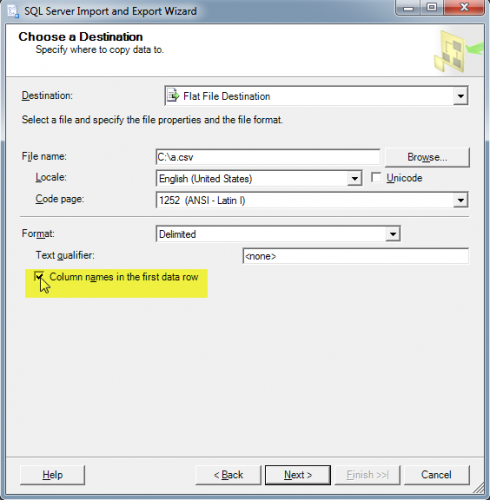

- #PSQL EXPORT TABLE TO CSV HOW TO#
- #PSQL EXPORT TABLE TO CSV INSTALL#
- #PSQL EXPORT TABLE TO CSV DRIVER#
- #PSQL EXPORT TABLE TO CSV MANUAL#
- #PSQL EXPORT TABLE TO CSV SOFTWARE#
Note the unnecessary data in lines 2 and 14
SELECT TOP 10 is for illustrative purposes onlyĪs you can see, the CSV export file is created but it looks a bit odd: Default CSV export from the sqlcmd utility. Lastly, choose a delimiter symbol with the -s option. Specify your server name in the -S option. Let’s export the same table without further ado: sqlcmd -S \\.\pipe\MSSQL$SQLEXPRESS\sql\query ^ The sqlcmd tool offers a range of options that you can explore by typing sqlcmd -? in the command line: List of sqlcmd options Step 2. If it's not, check out the Microsoft documentation page on sqlcmd for more guidance. Just type sqlcmd -? to see if it's already installed. For Windows users there's the sqlcmd utility. If you're allergic to clunky corporate interfaces, don't worry – a command line tool can save the day. This way you can start the export process without opening the SSMS. SQL table saved as CSV fileĪ quick lifehack: press the windows Start and search for “Import and Export Data”. Follow the wizard until the end and open the created CSV file. In the next window choose one source table. write an SQL query to specify the data to transfer. copy data from one or more tables or views, or. Press next and select whether you want to: Select a File Name on your local drive and configure other settings, such as file locale and encoding. Next, we need to pick Flat File as a Destination. Add Data Source in the SQL Server Import & Export Wizard Don’t forget to Select the database! Finally, press Test Connection and OK once finished. Here you need to provide a named pipe as a server name and select Windows Authentication. #PSQL EXPORT TABLE TO CSV DRIVER#
Select “Microsoft OLE DB Driver for SQL Server”, then press Properties and configure the connection. We need to configure the Data source first. Once connected, right-click on the database name and select Tasks - Export Data. Then connect to the database from the Object Explorer panel. Once you created a local SQL server and loaded a sample database, you can open the SQL Server Management Studio. Connect to the SQL Server and export SQL table to CSV
#PSQL EXPORT TABLE TO CSV HOW TO#
If you don’t already have a working SQL Server, we explained the installation process in another article on how to export MySQL to Excel.
#PSQL EXPORT TABLE TO CSV INSTALL#
Install SSMS and configure the local SQL Server This technique is handy if you occasionally need to create CSV exports. In this article, we'll demonstrate how to transfer data without running SQL statements.
#PSQL EXPORT TABLE TO CSV MANUAL#
It allows for both manual data transfer as well as writing SQL queries. The SQL Server Import and Export Wizard is a popular tool among engineers. One common way to perform SQL export to CSV is via SSMS. Let's roll up our sleeves and find out how you can get more in less time with creative automation techniques! Export SQL table to CSV via SQL Server Management Studio
Harnessing the power of n8n, a low-code automation tool, so you can sleep tight at night while your data is in sync 24/7. Speeding things up with a command line utility, so you can skip opening SSMS every time. 
Whipping up a CSV using SQL Server Management Studio (SSMS) – the classic method.We've got three nifty methods lined up for you: Let's dive into some cool ways to quickly export our MySQL data into a handy CSV file.

So, buckle up, folks! We've got an easy-to-follow tutorial on three ways to export SQL database to CSV: using SQL Server Management Studio, sqlcmd command line utility and n8n automation tool.ĭon't want to scroll to the bottom? Grab this free n8n workflow template on how to export SQL data to CSV now! How do I transfer data from SQL to CSV? It stores data "as is," so you won't mess up your data (which often happens with Excel date variables, for example).
#PSQL EXPORT TABLE TO CSV SOFTWARE#
It's a plain-text format, so no need for fancy software to read it. It's an open format, meaning everyone can use it. Integration via API doesn't always work out, but don't worry – you can always fall back on CSV transfers as a solid alternative.ĬSV has some pretty sweet advantages over Excel spreadsheets too: Transfer data in a universally accepted format, like CSV. If these apps don't share a common database, you've got two options: Average number of SaaS apps used per organisation. With companies using a gazillion SaaS apps these days, syncing data between different apps can be a real pain.







 0 kommentar(er)
0 kommentar(er)
